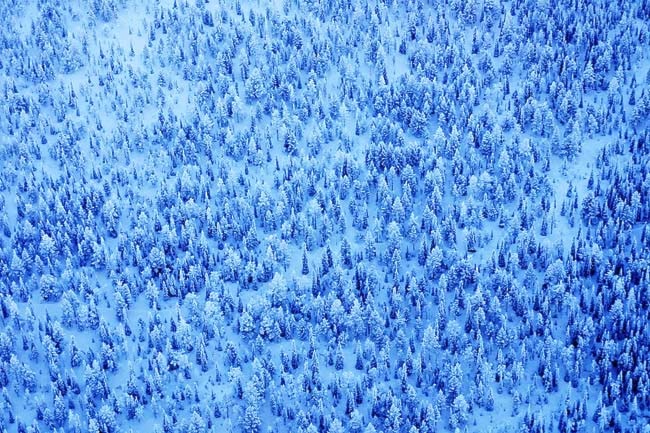Human civilization has always used the boreal forest.
Now, forest ecologist Herb Hammond shows us how not to destroy it.
For 25 years, Hammond has pioneered the field of ecosystem-based development, a system allowing communities to log, mine or develop the boreal forest without toppling the delicate infrastructure that holds it together.
“It’s basically how to be part of ecosystems in a respectful way,” Hammond recently told a group of people at the Alpine Bakery.
He showed them a map of an ecosystem-based development.
The most ecologically sensitive areas were immediately mandated off-limits.
Core forest areas are also left alone with pathways and linkages maintained between them.
“We protected osprey nests, we protected ecologically sensitive small, steep slopes; in some parts we cut little holes and left patches of trees—but we still had a forest,” said Hammond.
Only after planners—working in conjunction with community members and aboriginals—had determined what to save, did they decide what to use.
Clearcutting and replanting has long been promoted as a modern, and sustainable, approach to large-scale logging.
“Clearcutting is a bankrupt system because it doesn’t maintain long-term forest composition and structure,” said Hammond.
“Old growth forests are a non-renewable resource, we don’t know how to create them,” he said.
A “responsible clearcut” was flashed on the overhead projector.
The forest has indeed been cut bare, but trees have been left next to rivers and streams in an effort to bypass erosion.
That’s a “nice idea,” but next to useless since it ignores the many creeks and tributaries that serve the protected stream, said Hammond.
Tree planters will soon be dispatched to replant the barren forest, the crucial link of a sustainability chain that forestry companies are apt to promote.
But while tree planters can restore trees to a former forest, they can never restore the diversity of an old growth forest.
“(Replanting) homogenizes the landscape, it makes it simpler, it makes it open to loss from climate change,” said Hammond.
Planted trees also fail to develop strong root structures, making them vulnerable to high winds and surface disturbances.
It also creates open areas; the lack of cover can be treacherous to large mammals.
Tree branches typically deflect about 30 per cent of snowfall. Treeless areas rapidly become saturated with snow. For moose and deer, attempting to navigate these snow-filled open areas can prove deadly.
“If they have to work too hard to plow through snow that’s too deep, they run out of fat reserves and they don’t make it,” said Hammond.
Soils, the foundation of the boreal forest, are also irreparably harmed.
Boreal forests represent one fourth of the world’s capacity to absorb carbon emissions.
Of that, 84 per cent of carbon is stored in the soil—a dense nutrient-rich patchwork of rotting trees and plant matter.
“When we take that forest cover off, it rapidly decays and puts CO2 gases back into the atmosphere,” said Hammond.
“The annual carbon released from logging of the boreal forest is greater than all the carbon released from all the cars in Canada,” he said.
Ecosystem-based plans have already made their debut in 25 communities across Canada—to thunderous support from local populations.
“When you do the economics of this, they always play out really well for communities and people who work,” said Hammond.
“Loggers, wildcrafters, tourism operators—they benefit from it,” he said.
Loggers, especially, have flocked to a system that both reduces costs and ultimately “leaves a forest behind.”
Only large corporations and large governments have ever opposed ecosystem-based planning because it “focuses the economic returns with the people who do the work,” said Hammond.
Short-term profits may go down, but locals are spared the social and economic hardships of a damaged wilderness.
Water and air purification, the “non-dollar services of the forest” are annually worth about four times the one-time-only logging returns from a stand of trees.
Showing a slide of a common loon, Hammond explained that noise has largely driven the animals out of the lakes and rivers of the United States.
“This is an animal that likes solitude, and it’s now virtually extirpated from its former range in the Lower 48 states not because of water quality, but because of a lack of solitude,” he said.
The boreal forest ecosystem, despite its imposing three-continent status, is at its heart merely a fragile web of quirks.
Maintaining an ecosystem ultimately means respecting the idiosyncrasies that make it a whole.
A picture of a small fungus suddenly appeared before the assembled crowd: to the layman, a negligible curiosity. But to Hammond this is a critical link in the forest ecosystem.
“We need to understand that maintaining that fungus is more important than maintaining the spark plugs in our car; it’s what really makes us go,” said Hammond.
“The forest ultimately sustains us.”
Contact Tristin Hopper at
tristinh@yukon-news.com
